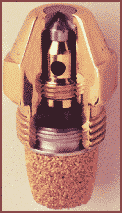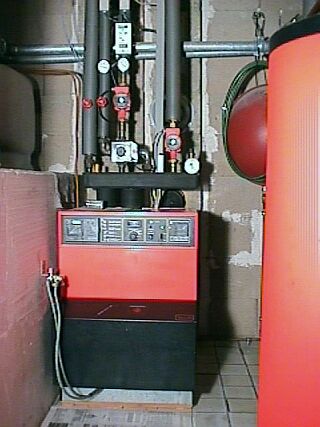Our optimization project: "old" heating system
- The heating system in words and pictures
- An overview of 10-years successful energy-saving in figures
- Graphs of running the heating
The heating system until 2001
A look at the picture will show you that the boiler isn't exactly state-of-the-art (1985 model, we changed it in March, 2001). Since optimization began, no changes have been made to the house, and the inside temperatur was always 20ºC. It should be remembered that the boiler has to warm the hot water too.
Data of the old system from 1985 - 2001 |
|
|

|
Special control and adjustment features |
|
|
The combination of two sensors in the heating circuit forming one mean value (at the very top of the picture) is a tailor-made unit from This mode of adjustment was the precursor of the Veltamat adjuster shown above, and has similar properties to the Klöckner adjuster used. |
 Ideal Graph of temperatures [Source: Velta] |
Wear or rust?Reducing the enormously high waste gas temperature (approx. 200░C or higher) was achieved using special metal inserts. No trace of corrosion could be found 14 years later, even though the system was always started near the dew point. |
|
An overview of 10-years successful energy-saving in figures
| Year |
Outside temp. Mean{░C} |
No. degree days 15/20{d*K} |
Burner on/off |
Burn time{h} |
Oil used {L/m▓} #10 |
What we did | |
|---|---|---|---|---|---|---|---|
| 1990 | 11.4 | 3147 | measurable | measurable | 10.98 | 12.14 | 15/9: Switch-on & running time counters built in |
| 1991 | 10.5 | 3540 | 13627 | 1781 | 12.78 | 12.16 | - |
| 1992 | 10.9 | 3291 | 10055 | 1473 | 12.15 | 12.42 | - |
| 1993 | 10.4 | 3509 | 12011 | 2089 | 11.31 | 11.85 | - |
| 1994 | 11.3 | 3188 | 11070 | 1493 | 9.76 | 10.30 | 04/94 Data gathering unit built in |
| 1995 | 11.3 | 3811 | 6289 | 1677 | 10.32 | 10.38 |
Min. running time & lower limit temp. changed |
| 1996 | 9.3 | 3948 | 3626 | 1918 | 11.72 | 9.99 | Jan.: Atomizer of 0.3/60º etc.. |
| 1997 | 11.1 | 3295 | 3274 | 1487.8 | 8.57 | 8.75 | Heating pump control & warm water vacation switch installed |
| 1998 | 11.0 | 3290 | 3749 | 1554.6 | 8.73 | 8.95 | Test: boiler cleaned, when waste gas >220ºC |
| 1999 | 11.6 | 3209.4 | 3234 | 1429 | 8.19 | 8.59 | (Jan.: This table created :-) long time off in summer |
| 2000 | 11.6 | 3049 | 2879 | 1340.4 | 7.97 | 8.80 | reducing the burners on/off |
| 10 years' total mean | |||||||
| 1991-00 | 10.90 | 3366 | 6986.8 | 1624.34 | 10.20 | 10.30 | 18.54% annual running time of burner |
| Savings in 2000, baseline 1991-1993 | 75.8% | 27.3% |
170.-euro oil + 33.-euro tax |
||||
Key to the 10-years overview:
